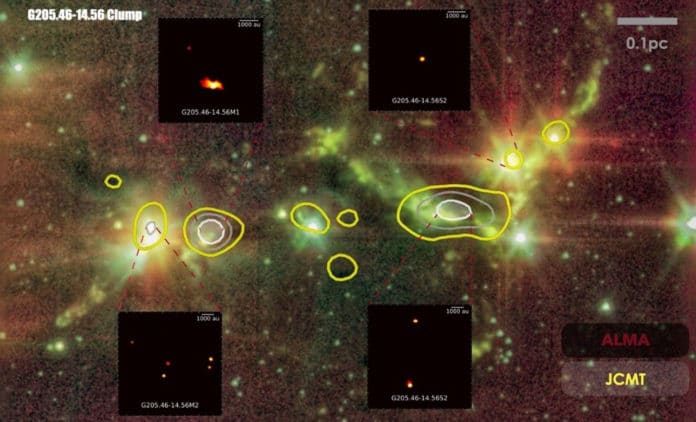Although binary and multiple star births are common, earlier studies of stellar nurseries have focused mainly on forming single stars. As a result, astronomers have long been baffled by the origin of binary/multiple star systems.
An international team led by researchers from the Shanghai Astronomical Observatory (SHAO) of the Chinese Academy of Sciences (CAS), studying stellar nurseries, revealed that nearly half the stars in the Galaxy are formed in binary/multiple stellar systems. They mainly found that the denser and more turbulent environments form multiple stars.
Star birth requires the gravitational collapse of cold, dense pockets of gas and dust, usually known as cores. Molecular clouds are known to contain these cores. Previous studies have focused on the way these molecular clouds affect stellar multiplicity.
In this new study, researchers observed the Orion Cloud complex using the James Clerk Maxwell Telescope (JCMT) in Hawaii and the Atacama Large Millimeter/submillimeter Array (ALMA) in Chile. Located about 1,500 light-years away in the Orion constellation, this stellar nursery is an ideal laboratory for testing various models of star formation.
The team studied 49 cold, dense cores in the Orion clouds in the star-forming process. Later, they unveiled the internal structures within these dense cores by using ALMA.
The ALMA observations revealed about 13 dense cores giving birth to binary/multiple stars, whereas other cores produced single stars. Researchers also estimated the physical characteristics of these dense cores- such as size, gas density, and mass- from the JCMT observations.
To their surprise, they learned that cores forming binary/multiple stars show greater H2 gas density and mass than those single forming stars. However, there is little difference in the sizes of various cores.
LUO Qiuyi, a Ph.D. student from SHAO and the first author of the study, said, “Denser cores are much easier to fragment due to the perturbations caused by self-gravity inside molecular cores.”
After observing 49 cores in the N2H+ (J=1-0) molecular line using the Nobeyama 45-meter telescope, the team found that N2H+ line widths for cores forming binary/multiple are statistically larger than those of cores forming single stars.
Prof. Ken’ichi Tatematsu, who led the Nobeyama observations, said, “These Nobeyama observations provide a good measurement of turbulence levels in dense cores. Our findings indicate that binary/multiple stars form in more turbulent cores.”
LUO said, “In a word, we found that binary/multiple stars tend to form in denser and more turbulent molecular cores in this study.”
LIU Sheng-Yuan, a co-author of the study, said, “JCMT has proven to be a great tool for uncovering these stellar nurseries for ALMA follow-up. With ALMA providing unprecedented sensitivity and resolution, we can do similar studies on a much larger sample of dense cores to better understand star formation.”
LIU Tie, corresponding author of the study and lead for the ALMA data, said, “As for future work, we have yet to look at the effect of magnetic fields in our analysis. Magnetic fields may suppress the fragmentation in dense cores. So, we are excited to focus the next stage of our research on this area using JCMT and ALMA.”
Journal Reference:
- Qiu-Yi Luo et al. ALMA Survey of Orion Planck Galactic Cold Clumps (ALMASOP): How Do Dense Core Properties Affect the Multiplicity of Protostars? The Astrophysical Journal, Volume 931, Number 2. DOI: 10.3847/1538-4357/ac66d9
